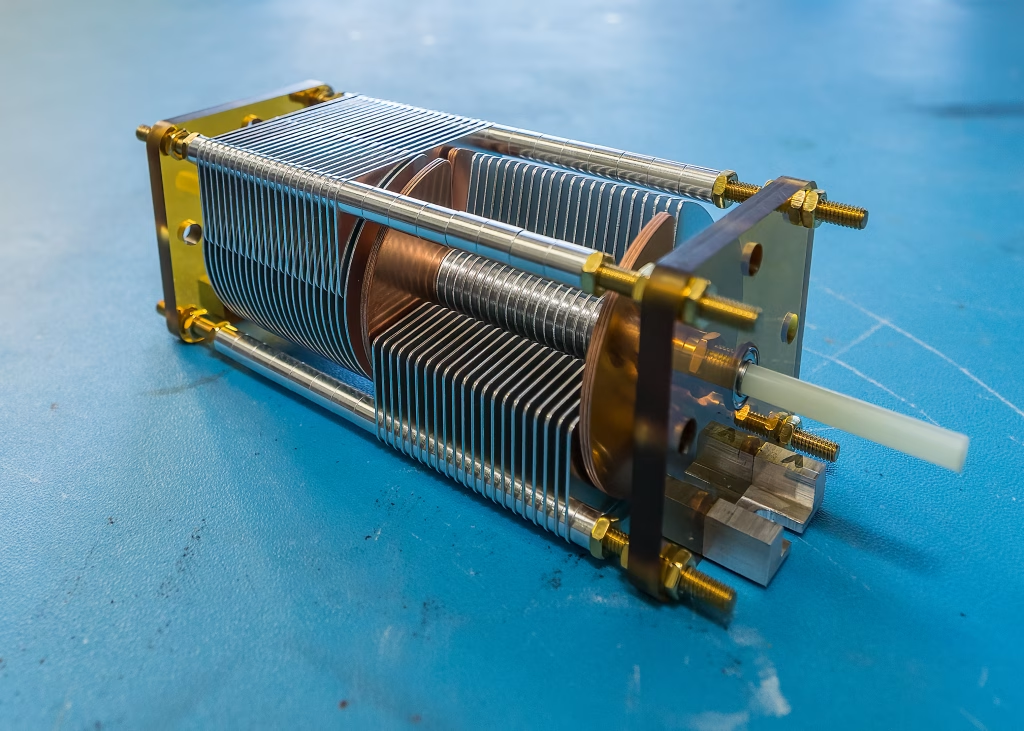Wind, solar and hydropower are a good start when it comes to renewable energy, but the real prize is lurking just off the coast: There’s enough energy produced by ocean waves and tides around the world to exceed all human energy needs—if we can unlock it.
A unique type of electric machine might hold the key.
Developed by David Skrovanek, a University of Wisconsin-Madison electrical and computer engineering PhD student, and his advisor, Daniel Ludois, a professor of electrical and computer engineering, the device is in stage III of the U.S. Department of Energy’s Innovating Distributed Embedded Energy Prize (InDEEP) competition, in which teams are tasked to develop new materials and technologies to harvest wave energy.
Most electricity is produced using electromagnetic induction, in which an electromagnet spins rapidly inside a stationary magnetic field. Wave energy, however, is slow and irregular. “If you compare that to the way we generally produce electricity with fast-spinning turbines, there’s an inherent mismatch,” says Skrovanek. “Another challenge is transmitting that power to land, where it’s going to be used.”
 An early bench-scale version of Skrovanek and Ludois’s high-voltage electrostatic converter. Larger versions of these machines could make it possible to harvest energy from slow-moving waves.
An early bench-scale version of Skrovanek and Ludois’s high-voltage electrostatic converter. Larger versions of these machines could make it possible to harvest energy from slow-moving waves.
Using existing technology would require building costly aircraft-carrier-sized platforms to house the electronics and transformers needed to convert wave power to energy for electrical grids. That’s because low-voltage energy produced by ocean waves would need to be repeatedly “stepped up” to a higher voltage before being carried to shore. Even then, it would lose some efficiency along the way. “It’s not surprising to see that as a huge barrier to harnessing any sort of offshore energy resource,” says Ludois.
A device discovered by Benjamin Franklin could be a game-changer. Today Ludois and researchers at his spin-off company C-Motive are improving Franklin’s electrostatic motor, which is ideally suited for industrial automation and robotics. It turns out the tech is also good for wave energy, which is what Skrovanek is adapting it for. Instead of electromagnetism, the motor is powered by Coulomb force—or the attraction and repulsion between opposite or like electrical charges. It’s the same force—static electricity—that will shock you if you shuffle along the carpet and touch a doorknob.
“Electrostatics are sort of binary; they’re really good with things moving really slow or moving really fast,” says Ludois.
Electrostatic machines could be used to harness energy from waves since they can produce high-voltage electricity from the waves—meaning there’s no need to step up the juice using an aircraft-carrier-sized platform. Instead, the electricity could be sent directly into the grid using high-voltage direct current (HVDC) transmission.
For phase I of the InDEEP competition, Skrovanek, Ludois and Professor Ted Brekken of Oregon State University—aka team Condensed Wave Matter—developed a theoretical framework for their project. Advancing to round II, Skrovanek built a proof-of-concept benchtop prototype of their high-voltage machine, which earned them a spot in the final round. Now, the team is building a larger prototype, linking together five of the machines. Experts will assess this prototype in January 2025 before a winner is selected in March.
Whatever the outcome, the team is committed to moving the project forward. It’s also the basis of Skrovanek’s PhD research. While there are many other hurdles in the way of harvesting wave energy, the researchers believe the technology could provide energy-conversion solutions for any marine technology, whether that’s offshore wind farms, floating or undersea nuclear power, tides or waves.
Featured image: PhD student David Skrovanek (left) and Professor Daniel Ludois. Their high-voltage electrostatic converter could help wave energy and other marine energy sources become a reality. Credit: Joel Hallberg.